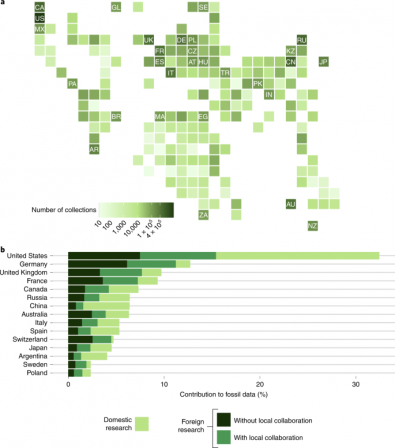Colonial history and global economics distort our understanding of deep-time biodiversity
Source: Nature
Sampling biases in the fossil record distort estimates of past biodiversity. However, these biases not only reflect the geological and spatial aspects of the fossil record, but also the historical and current collation of fossil data. We demonstrate how the legacy of colonialism and socioeconomic factors, such as wealth, education and political stability, impact the global distribution of fossil data over the past 30 years. We find that a global power imbalance persists in palaeontology, with researchers in high- or upper-middle-income countries holding a monopoly over palaeontological knowledge production by contributing to 97% of fossil data. As a result, some countries or regions tend to be better sampled than others, ultimately leading to heterogeneous spatial sampling across the globe. This illustrates how efforts to mitigate sampling biases to obtain a truly representative view of past biodiversity are not disconnected from the aim of diversifying and decolonizing our discipline.
Main
The fossil record is our only direct evidence of how life on Earth has evolved over time, and reconstructions of deep-time biodiversity provide critical insights into future biodiversity change. The fossil record, upon which these reconstructions are based, is known to be incomplete and unevenly distributed across the globe1,2,3. Various taphonomic, geological and anthropogenic factors have been shown to introduce biases into estimates of deep-time biodiversity, extinction and evolution, and decades of research have documented and attempted to analytically mitigate their effects4,5,6,7. However, considerably less attention has been paid to how historical, social and economic factors influence the global distribution of fossil occurrences, and their consequent effects on our understanding of deep-time biodiversity.
The natural sciences were developed around an extractive process facilitated by European colonialism in the nineteenth century. When zoological and botanical specimens were uncovered during colonial expeditions, they were shipped back to the respective imperial capitals, to be housed in museums, which were rapidly increasing in numbers to accommodate the influx of scientific material8. Many specimens collected during the colonial era are still being used for scientific purposes today by researchers based in these countries. Recently, plankton samples collected from the equatorial Pacific Ocean during the HMS Challenger expedition in the nineteenth century —that made use of the extensive colonial network and relationships developed by Great Britain during that time for the purpose of scientific exploration9—were used for a study led by British authors10. Fossil specimens were no exception, and their collection was dominated by imperial systems and exchanges11. For example, Charles Darwin aboard the HMS Beagle collected fossils in South America that were sent to London and studied by British palaeontologists12. These extractive research practices continue to this day within the natural sciences13, but especially in palaeontology where fossils and their collection underpin the discipline14.

Cont'd.
LINK:
https://www.nature.com/articles/s41559-021-01608-8